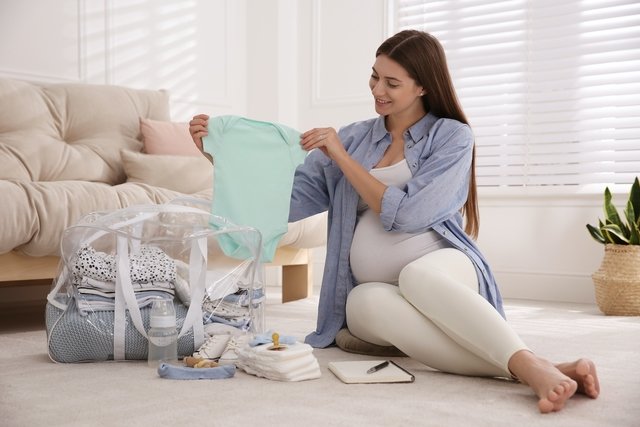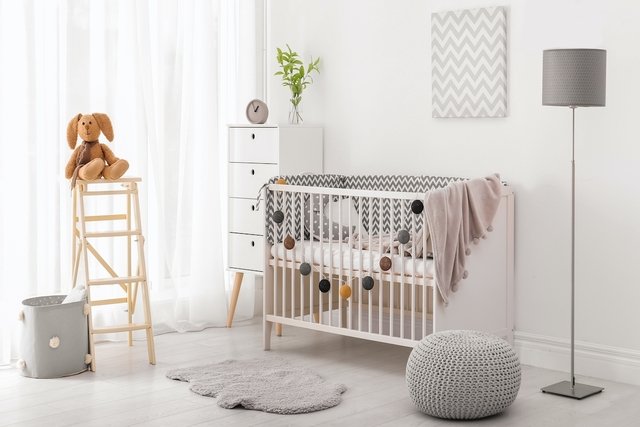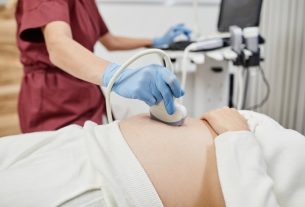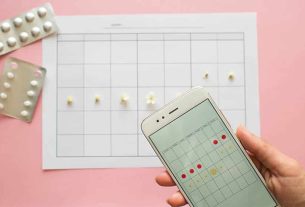The moment of the baby’s arrival is very important, and therefore you must have all things prepared in advance to avoid stress or unforeseen events, so it is recommended to have the mother’s and baby’s bags ready from the 35th week of birth. gestation.
To prepare your suitcase for maternity, it is important to include items for the newborn, such as disposable diapers, diaper rash cream and sets of clothes, and also for women, such as nightgowns suitable for breastfeeding, bathrobe and night pad, for example.
Furthermore, it is also important to prepare the layette at home, so that everything is ready to receive the baby after hospital discharge, including furniture, such as a crib and changing table, clothes and personal hygiene products.

What to take for the baby
To organize the maternity bag for the baby, it is important to take into account the season in which the birth is expected. This is because in winter it is recommended to wear warmer clothes. In summer or mid-season, you can wear lighter clothes that cover and warm the baby, as the newborn does not yet have control over their body temperature.
Some items from the baby’s layette that should be taken to the hospital are:
- 4 to 6 sets of clothes, such as long-sleeved jumpsuits, bodysuits, vests and cardigans;
- 6 pairs of socks;
- 2 blankets to wrap the baby;
- 2 to 4 gloves and hats, if it’s winter;
- 1 blanket, if it’s winter;
- 1 soft towel with a hood, preferably;
- 2 to 4 mouth diapers to put on your shoulder when picking up your baby;
- 2 cloth diapers;
- 2 diaper towels;
- 2 packs of disposable diapers;
- 1 pack of wet wipes;
- 1 fine comb or brush suitable for babies;
- 1 neutral shampoo for babies;
- 1 liquid soap suitable for newborns;
- 1 baby moisturizer, preferably hypoallergenic;
- 1 diaper rash cream;
- 1 package of cotton balls;
- 1 small bottle of 70% alcohol;
- 4 packs of sterile gauze;
- 1 box of cotton swabs;
- 1 bag to store dirty clothes;
- Complete outfit for leaving the maternity ward;
- Baby comfort for leaving the baby and transporting it in the car.
It is important that the baby’s clothes are washed in advance, with neutral soap, as well as dried in the sun and ironed.
Furthermore, the number of items for the baby may vary depending on the length of hospital stay, which can be around 1 to 2 days, in the case of a natural birth, or 2 to 3 days in the case of a cesarean section.
What to bring to your wife
It is important that some items from the mother and baby’s layette are taken to the hospital so that they can be used postpartum. Therefore, it is recommended that the following be taken to the hospital:
- 2 nightgowns with front opening, suitable for breastfeeding;
- 1 bathrobe or robe;
- 1 postpartum belt recommended by the doctor;
- 2 bras suitable for breastfeeding. The recommendation is that these bras be purchased in the last month of pregnancy, as a woman’s body changes a lot during pregnancy;
- Moisturizing and protective cream for nipples;
- Breastfeeding pads or pads to keep nipples dry;
- 3 or 4 high-seam panties, comfortable for postpartum;
- Socks if necessary;
- Slippers for the bath and bedroom;
- 1 pack of night pad;
- Some personal hygiene products, such as towels, soap, mirror, lipstick, toothbrush and toothpaste, hairbrush, cotton swabs, shampoo or conditioner, for example;
- Comfortable, easy-to-wear and loose-fitting clothing for leaving the hospital;
- 1 bag to store dirty clothes.
To avoid forgetting, it is recommended to make a list and place the items in a medium-sized suitcase that is easy to transport. It is also important that the two suitcases are stored together and in an easily accessible place, preferably.

House trousseau
For the home layette, some items are important to receive the baby after hospital discharge, and include:
1. Furniture
Furniture is one of the important things in a baby’s layette, as it not only promotes comfort for the baby but also for the mother during breastfeeding. To do this, it is important that the room has a crib, a place to change diapers, an armchair or sofa for breastfeeding, a closet and a side table.
2. Hygiene Products
Baby hygiene products are another very important item on the list, requiring:
- diaper rash creams;
- Cotton swab boxes;
- Brush or comb suitable for the baby;
- Round tip scissors;
- 70% alcohol%;
- Saline 0.9%;
- Cotton;
- wet wipes;
- Neutral soap;
- Shampoo neutro;
- Thermometer to measure the baby’s temperature;
- Thermometer for the bath;
- Bathtub;
- Hooded towels;
- Disposable and cloth diapers;
- Medium bag to carry products for baby changes outside the home.
To calculate the number of diapers needed for your baby, try our calculator. To start, choose how long diapers you need: weeks or months, or for the baby shower:
3. Outfits
The baby’s clothes must be comfortable and easy to change during diaper changes, and the following are recommended: shirts, jumpsuits with and without sleeves, t-shirts, swaddles, sets with a coat, cap, socks and shoes, bib, blankets, blankets, sheets , pillowcases, crib protector and pillow.
4. Food
To feed the baby, there are some items that are necessary such as: bottle, pacifier, plate, cutlery, cup with handle. Generally, in the first months of life these items are not used, because, in most cases, the baby’s only source of nutrition is breastfeeding. However, as the baby develops, the pediatrician may indicate the beginning of water and food consumption, as these items are necessary. See what baby feeding is like from 0 to 12 months.
5. Baby stroller
When buying a baby stroller, you need to take into account the comfort, resistance and practicality of the stroller. There are some types of strollers that are very practical, as they come together with the car seat, making it possible to use the same base in both situations. Furthermore, there are also strollers that are suitable for different ages, which means they are adapted to accompany the baby’s growth.
Before purchasing the stroller, you should always try taking it for a walk around the store, to ensure that it is light and easy to maneuver and that it has all the features you need.

Sign up for our newsletter and stay up to date with exclusive news
that can transform your routine!
Warning: Undefined array key "title" in /home/storelat/public_html/wp-content/plugins/link-whisper-premium/templates/frontend/related-posts.php on line 12
Warning: Undefined array key "title_tag" in /home/storelat/public_html/wp-content/plugins/link-whisper-premium/templates/frontend/related-posts.php on line 13




